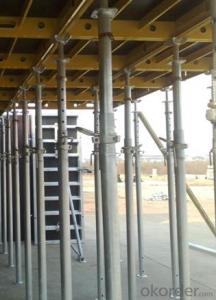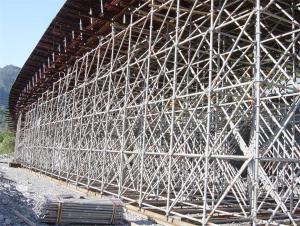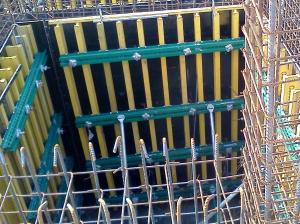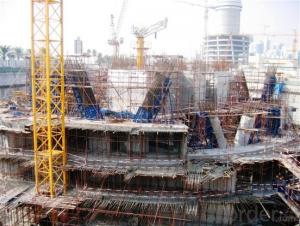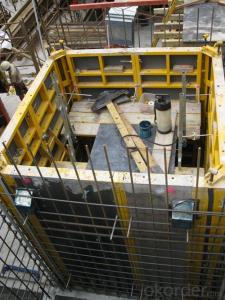Ring-Lock Scaffolding ,Tower Scaffolding with Hot or Cold Galvanized Surface
- Loading Port:
- Shanghai
- Payment Terms:
- TT OR LC
- Min Order Qty:
- 1000 m²
- Supply Capability:
- 100000 m²/month
OKorder Service Pledge
OKorder Financial Service
You Might Also Like
1.Structure of Ring lock Description
Ringlock Scaffolding system is the most popular used Scaffolding system in the world.It will greatly reduce the cost because of the following advantages
Packaging & Delivery
Packaging Details:
Pallet or bag or upon client's request
Delivery Detail:
35days
2.Main Features of Ringlock
It will greatly reduce the cost because of the following advantages
1)Using less pipes
2)Easy to install
3)It can be used again and again for nearly 20years
3.Ring lock product pictures:
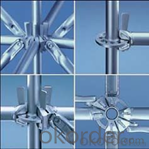
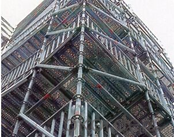
4.Ringlock Product Description
Type: ringlock scaffolding diagonal Brace
specification : Ø48.3×3.20
material:: steel Q235
Finished: Hot DIP galvanized, painted
Diagonal length(m) :Weight(kg)
0.9m * 1.25m 6.28
1.25m * 2.7m 11.45
5.FAQ
We have organized several common questions for our clients,may help you sincerely:
1)How about your company?
CNBM International Corporation, China National Building Materials (Group) Corporation, is one of the largest companies in China building material equipment industry, Our formwork and scaffolding are largely used in both domestic and all over world;
2)How many Scaffolding your company have?
Here comes our 5 types of Scaffolding systems:
- Cup lock Scaffolding(C-Lock Scaffolding)
- Ring lock Scaffolding
-Kwistage Scaffolding
-H-frame Scaffolding
-ID15 Scaffolding Tower, this type Scaffolding is the most widely used in construction, such like bridge.
3)How long can we receive the product after purchase?
Lead time is about 30days after getting the signed PI and deposit.
- Q:What are the different methods of releasing the formwork from the concrete surface?
- There are several methods for releasing the formwork from the concrete surface, depending on the type of formwork used and the desired finish of the concrete. Here are some common methods: 1. Stripping the formwork: This is the most straightforward method and involves physically removing the formwork from the concrete surface. It can be done by disassembling the formwork panels or by lifting the formwork away from the concrete using cranes or other lifting equipment. 2. Formwork removal agent: This method involves using a releasing agent or formwork removal agent to facilitate the release of the formwork from the concrete surface. These agents are typically sprayed or brushed onto the formwork before pouring the concrete. The chemicals in the agent create a barrier between the formwork and the concrete, allowing for easier removal. 3. Thermal release: In this method, heat is used to release the formwork from the concrete surface. Heating the formwork causes it to expand, creating a gap between the formwork and the concrete, which allows for easy removal. This method is commonly used with metal formwork. 4. Water blasting: For some types of formwork, such as plywood or timber, water blasting can be used to release the formwork from the concrete surface. High-pressure water jets are directed at the formwork, which helps to loosen it and separate it from the concrete. 5. Mechanical release: This method involves using mechanical tools or equipment to remove the formwork from the concrete surface. It can include using pry bars, hammers, or other tools to loosen and dislodge the formwork from the concrete. It is important to note that the method of releasing the formwork should be carefully chosen to avoid damaging the concrete surface or compromising its structural integrity. The choice of method depends on factors such as the type of formwork, the desired finish of the concrete, and the specific requirements of the project.
- Q:What are the common safety training requirements for using steel frame formwork systems?
- The use of steel frame formwork systems requires adherence to several safety training requirements. These include: 1. Acquiring a thorough understanding of the equipment: Users must receive training on the proper assembly, disassembly, and operation of the steel frame formwork systems. This includes familiarizing themselves with the various components, their functions, and how they fit together. 2. Ensuring the use of personal protective equipment (PPE): Trainees must be educated about the significance of wearing appropriate PPE, such as hard hats, safety goggles, gloves, and steel-toed boots. They should also be taught how to effectively utilize, maintain, and inspect their PPE to ensure its efficacy. 3. Implementing fall protection measures: Working with steel frame formwork systems involves the risk of falls from heights. Safety training should cover the usage of fall protection equipment, such as harnesses, lanyards, and anchor points. Users must be trained on how to correctly install and utilize these systems to prevent falls. 4. Adhering to load capacity and weight limits: Steel frame formwork systems have specific load capacity and weight limits that must be followed. Training should focus on comprehending these limits and how to safely calculate and distribute loads. Users should be aware of the dangers associated with overloading and the potential compromise it poses to the stability and safety of the structure. 5. Practicing proper handling and storage techniques: Training should encompass the correct methods for handling and storing steel frame formwork components. This includes instruction on lifting, moving, and securing the equipment to prevent accidents and damage. Users should also be educated on appropriate storage practices to maintain the structural integrity of the components and prevent rust or deterioration. 6. Identifying and mitigating hazards: Safety training should emphasize the crucial task of identifying potential hazards on the construction site and implementing measures to mitigate them. Users should be trained to recognize and address hazards such as uneven ground, overhead obstructions, electrical hazards, and adverse weather conditions. 7. Familiarizing trainees with emergency procedures: Trainees should receive guidance on emergency procedures, including evacuation plans, first aid, and reporting protocols. They should understand how to respond to accidents, injuries, or equipment failures and possess effective communication skills in the event of an emergency. In summary, comprehensive safety training for the use of steel frame formwork systems is essential to safeguard workers' well-being and ensure successful completion of construction projects. It is crucial to provide thorough training that covers all potential risks and equips users with the knowledge and skills necessary to work safely and efficiently with these systems.
- Q:What types of projects are steel frame formwork commonly used for?
- Steel frame formwork is commonly used for various types of projects, such as high-rise buildings, bridges, tunnels, and large-scale infrastructure projects. It provides a sturdy and reliable structure that can withstand heavy loads and ensure the efficient construction of concrete elements.
- Q:How does steel frame formwork compare to other formwork systems in terms of durability?
- Compared to other formwork systems, steel frame formwork is renowned for its exceptional durability. This can be attributed to the inherent strength and resilience of steel as a construction material. Steel possesses a high tensile strength, enabling it to withstand heavy loads and resist deformation or structural failure. Unlike timber or aluminum formwork systems, steel frame formwork is less prone to warping, rotting, or corrosion. As a result, it exhibits high resistance to the elements, allowing it to endure extreme weather conditions and maintain its structural integrity for an extended period. Moreover, the design of steel frame formwork emphasizes reusability, which further enhances its overall durability. The system's modular nature facilitates easy assembly and disassembly, minimizing damage during the construction process. Once a project is completed, the formwork can be dismantled and utilized in future projects, reducing waste and generating cost savings. When it comes to durability, steel frame formwork offers a significant advantage over alternative systems. Its robustness, resistance to deterioration, and ability to be reused make it a reliable choice for construction projects, especially those that require long-lasting structures.
- Q:Can steel frame formwork be used in projects with limited construction site water supply or drainage systems?
- Yes, steel frame formwork can be used in projects with limited construction site water supply or drainage systems. Steel frame formwork is a versatile and durable system that can be used in various construction projects. Unlike traditional timber formwork, steel frame formwork does not rely on water for its stability and strength. Steel frame formwork is designed to be self-supporting and can be easily assembled and disassembled, making it suitable for projects with limited water supply or drainage systems. In addition, steel frame formwork can withstand high pressures and can be used in projects that require higher concrete pouring rates. Furthermore, steel frame formwork is reusable, which means it can be used multiple times in different projects. This can help reduce the overall construction cost and waste generation. Overall, steel frame formwork is a practical choice for projects with limited construction site water supply or drainage systems. Its versatility, strength, and reusability make it a reliable solution for various construction needs.
- Q:How does steel frame formwork contribute to the overall waterproofing of a concrete structure?
- Steel frame formwork does not directly contribute to the overall waterproofing of a concrete structure. Its main purpose is to provide temporary support and shape to the concrete during construction. However, if the steel frame formwork is designed and installed properly, it can help ensure a precise and tight fit, which can indirectly contribute to the overall waterproofing by minimizing the potential for water leakage and improving the overall quality of the concrete structure.
- Q:What are the different types of shoring systems used with steel frame formwork?
- There are several types of shoring systems commonly used with steel frame formwork, including adjustable steel props, aluminum props, modular shoring towers, and hydraulic shoring systems.
- Q:What are the lead times for manufacturing steel frame formwork?
- The lead times for manufacturing steel frame formwork can vary depending on various factors such as the complexity of the design, size of the project, and the current workload of the manufacturer. However, on average, lead times for manufacturing steel frame formwork can range from a few weeks to a couple of months. It is recommended to consult with the specific manufacturer to get an accurate estimate based on the project requirements.
- Q:Can steel frame formwork be used for healthcare facilities?
- Yes, steel frame formwork can be used for healthcare facilities. Steel frame formwork is a versatile and durable construction method that provides a high level of strength and stability, making it suitable for various types of buildings, including healthcare facilities. Healthcare facilities require robust and long-lasting structures to support the heavy equipment and machinery used in the medical field. Steel frame formwork offers the necessary strength to withstand the weight and stress associated with healthcare equipment. Furthermore, steel frame formwork allows for flexible design options, making it easier to accommodate the specific layout and requirements of healthcare facilities. The modular nature of steel frame formwork allows for easy customization, ensuring that the construction can adapt to the unique needs of healthcare facilities, such as operating rooms, patient rooms, laboratories, and other specialized areas. In addition to its strength and flexibility, steel frame formwork also provides excellent fire resistance, which is crucial for healthcare facilities. Steel has a high melting point, and when properly fireproofed, it can effectively withstand and contain fires, minimizing the risk of spreading and ensuring the safety of patients and staff. Overall, steel frame formwork is a suitable choice for healthcare facilities due to its strength, flexibility, and fire-resistant properties. By using this construction method, healthcare facilities can be built to withstand the demanding requirements of the medical field and provide a safe and durable environment for patients and healthcare professionals.
- Q:What are the different types of clamping systems used with steel frame formwork?
- Steel frame formwork commonly utilizes several types of clamping systems to securely hold the formwork panels together during the concrete pouring process. One frequently employed clamping system is the wedge clamp system, which comprises wedge-shaped clamps inserted into slots on the formwork panels. When driven into the slots, the wedges establish a firm and secure connection between the panels, preventing any movement or shifting. Another commonly used system is the pin and wedge system, which employs steel pins inserted into pre-drilled holes in the formwork panels. Once the pins are in place, steel wedges are driven into slots on the pins, creating a robust connection between the panels. Some clamping systems combine pins and clamps, utilizing pins inserted into pre-drilled holes and clamps tightened around the pins to hold the panels together. Additionally, there are clamping systems that utilize bolts and nuts, as well as systems employing hydraulic or mechanical mechanisms to secure the formwork panels. The selection of the appropriate clamping system depends on various factors, including the size and complexity of the formwork structure, the required strength and stability, and the specific requirements of the construction project. It is crucial to carefully evaluate these factors in order to ensure the safety and success of the formwork installation.
1. Manufacturer Overview |
|
|---|---|
| Location | |
| Year Established | |
| Annual Output Value | |
| Main Markets | |
| Company Certifications | |
2. Manufacturer Certificates |
|
|---|---|
| a) Certification Name | |
| Range | |
| Reference | |
| Validity Period | |
3. Manufacturer Capability |
|
|---|---|
| a)Trade Capacity | |
| Nearest Port | |
| Export Percentage | |
| No.of Employees in Trade Department | |
| Language Spoken: | |
| b)Factory Information | |
| Factory Size: | |
| No. of Production Lines | |
| Contract Manufacturing | |
| Product Price Range | |
Send your message to us
Ring-Lock Scaffolding ,Tower Scaffolding with Hot or Cold Galvanized Surface
- Loading Port:
- Shanghai
- Payment Terms:
- TT OR LC
- Min Order Qty:
- 1000 m²
- Supply Capability:
- 100000 m²/month
OKorder Service Pledge
OKorder Financial Service
Similar products
New products
Hot products
